Coleus plant is also known as the Mayana plant and the painted nettle with its bright colors, a wide variety of foliage colors, leaf shapes, and forms that are easy to grow and durable.
Many grow coleus as annual bedding plants or planted in pots to create dramatic, colorful borders in full sun, bright light, and some in part shade.

It’s been reclassified in the genera Plectranthus and Solenostemon.
Other common names for this plant include:
- Lampuyana
- Dafronaya
- Tampunaya
- Daponaya
Learn more about –> Annual Flowers for Shade.
Coleus comes with lots of color combinations and is ideal for anyone who wants color in a hurry – in the garden, around the patio, or as an indoor plant.
There’s no need to wait for flowers; the leaf color of the foliage is the coleus calling card.
Most gardeners pinch off the non-spectacular flower spikes to help keep plants bushy and vigorous. The flowering cycle takes lots of plant energy away from the plant.
Coleus plant varieties like Coleus come in a wide range of cultivars, colorful foliage combinations, and leaf patterns such as the purple coleus or coleus rainbow mix.
They are excellent container gardening multi-colored leaf plants.
Some popular varieties/colors include:
- Coleus Rainbox Mix
- Purple Coleus
- Coleus Watermelon
- Campfire Coleus
- Green Coleus
- Coleus Indian Summer
- Pink Coleus
Some are green marked with ivory, ochre, apricot, brown, pink, red, or purple. A few are of solid color; most have two-tone borders or speckles.
- Coleus For Pots, Planters, and Borders
- Coleus Plant Quick Care Tips
- Coleus Care – Pinch To Control Size and Fullness
- How To Take Coleus Cuttings
- Starting Coleus From Seed
- Many Uses For Coleus
- Growing Coleus Plants – Climate Counts
- Good Coleus Care Means Feeding Coleus Well
- Coleus Care Pest and Disease
- Coleus Plant Care – Questions and Answers
- Coleus Plant Facts
- Closing Thoughts on Coleus
Coleus For Pots, Planters, and Borders
Coleus adjusts beautifully to life in pots, planters, flower beds, or borders. If you keep a plant in a small container, it will stay quite small.
But, transfer this ornamental flower to a larger pot or into the open garden, and it may grow over 2′ feet tall during warm weather if it is well fed.
Coleus Plant Quick Care Tips
- Botanical Name: Coleus blumei
- Common Name(s): Coleus, Painted Nettle
- Synonyms: Plectranthus scutellarioides
- Family & Origin: Lamiaceae family, native to Southeast Asia and Australia
- Growability: Easy to grow
- Grow Zone: USDA zones 10-11
- Size: Grows up to 3′ feet tall and 2′ feet wide
- Flowering: Produces small, insignificant flowers
- Light: Prefers bright, indirect light but can tolerate some shade
- Humidity: Thrives in high humidity environments
- Temperature: Prefers temperatures between 60-70°F
- Soil: Well-draining soil with a pH between 6.0-7.5
- Water: Keep soil consistently moist but not waterlogged
- Fertilizer: Feed with a balanced fertilizer every 2-3 weeks during the growing season
- Pests & Diseases: Susceptible to spider mites, mealybugs, and fungal diseases
- Propagation: Propagated through stem cuttings or by seed
- Plant Uses: Used as a decorative indoor or outdoor plant, and in traditional medicine for its anti-inflammatory properties.
Full Sun Coleus For A Blast Of Leaf Colors
Coleus Care – Pinch To Control Size and Fullness
If you don’t want coleus to grow tall, you can control its size by pruning. Take coleus leaf tips off the main stems, and the plant will branch out.
New leaves and then branches will form from the bud above almost every leaf.
The more tips you pinch off or grow coleus, the more branches there will be, although the leaves will be smaller than on a plant with fewer branches.
Remove the inner branches, and the Mayana leaves will grow larger. Remove the lower branches of the painted nettle, creating a plant shaped like a tree.
How To Take Coleus Cuttings

You can multiply your plants as much as you want. The color and leaf patterns of plants started from cuttings will be the same as that of the original plant.
The 2 to 4-inch tips you prune off can be used to start new plants.
Nip off the lower leaves of these cuttings and cut the base of the stem with a clean slant.
Set the cutting at least an inch deep in a growing medium like soil, sand, peat moss, vermiculite, or even water.
Keep the medium moist (or the water fresh) but add no fertilizer. Roots will begin to develop in a few days. In summer, these cuttings can be rooted right in a shaded garden bed.
After two or three weeks, take hold of a cutting and pull it upward gently. If it resists your pull, the young plant has a good root system and is ready for transplanting.
This video gives complete and simple to follow instructions on taking cuttings from your Coleus so you can overwinter your coleus indoors until the next season.
mrBrownThumb explains the procedure in a very easy-to-understand way while demonstrating the technique to show that anyone would be able to do it. Watch the video below.
Starting Coleus From Seed
Plants started from a packet of coleus seeds vary greatly in color and leaf pattern. Many offerings are a rainbow mixture that yields a wide selection of plants.
When growing coleus seeds, you can select your favorites to propagate more from cuttings.
Some coleus varieties are predominantly one color or tend to have small or large leaves.
Try separating them into fringed, striped, spotted, or plain-leaved strains. These strains were through hybridization and seed selection.
Some of the newest and most interesting coleus hybrids come from Hort Couture and their Coleus Under the Sea® series.
Sow seed indoors at any time or outdoors when the temperature is about 60° or 70′. Coleus in seed starter kits is as easy to grow as baking a package cake mix. All you need to do is add water.
Video: University Of Florida’s Coleus Breeding Program
Many Uses For Coleus
Small coleus plants make good garden border edging plants if you keep them pruned low.
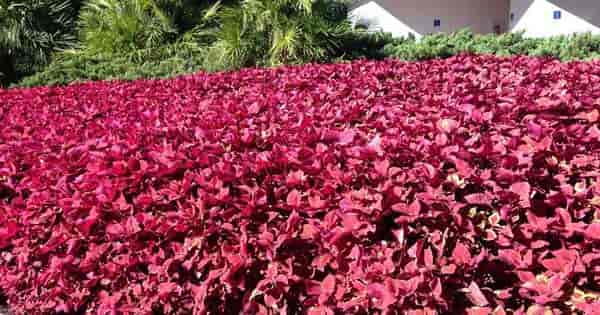
Create dramatic effects by planting a single variety like this “redhead coleus” at Epcot.
Larger plants look attractive when used in geometric designs or when scattered informally in groups in tender perennial borders.
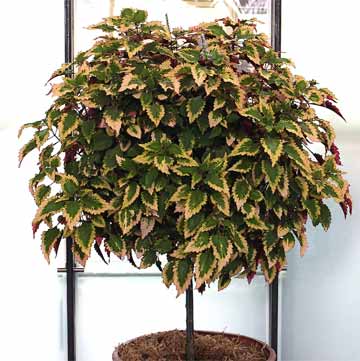
Use coleus in direct sunlight in terrace boxes, patio planters, and hanging baskets too.
Combine them with annuals like petunias or with other foliage plants like philodendrons or ferns. Coleus can even be grown and trained into a tree.
Moreover, Mayana plants are commonly used in traditionally used folkloric medicine for soreness, pain, headache, swelling, diarrhea, delayed menstruation, and cuts.
it’s also commonly used to treat boils, relieve symptoms of cough, and lower fever heat.
Moreover, it’s also a medicinal plant for serious illnesses like diabetes, ulcers, Glaucoma, and hemorrhoids.
Its leaves are also known for their health benefits, including alkaloids, flavonoids, antioxidants, saponins, tannins, volatile oil, and quercetin.
Related: Learn How To Grow a Coleus Standard — Step-By-Step
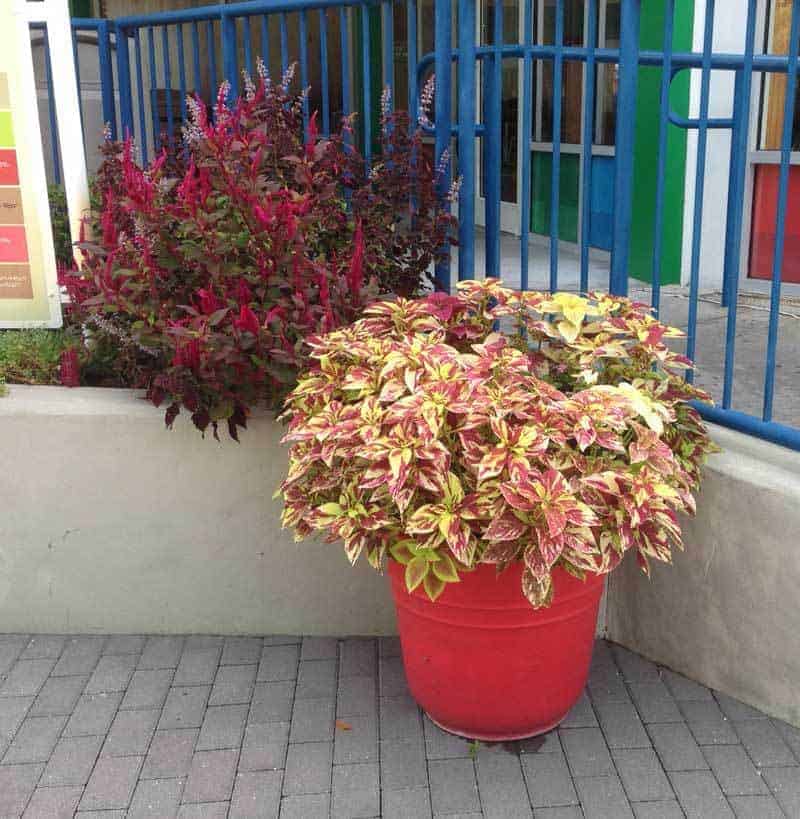
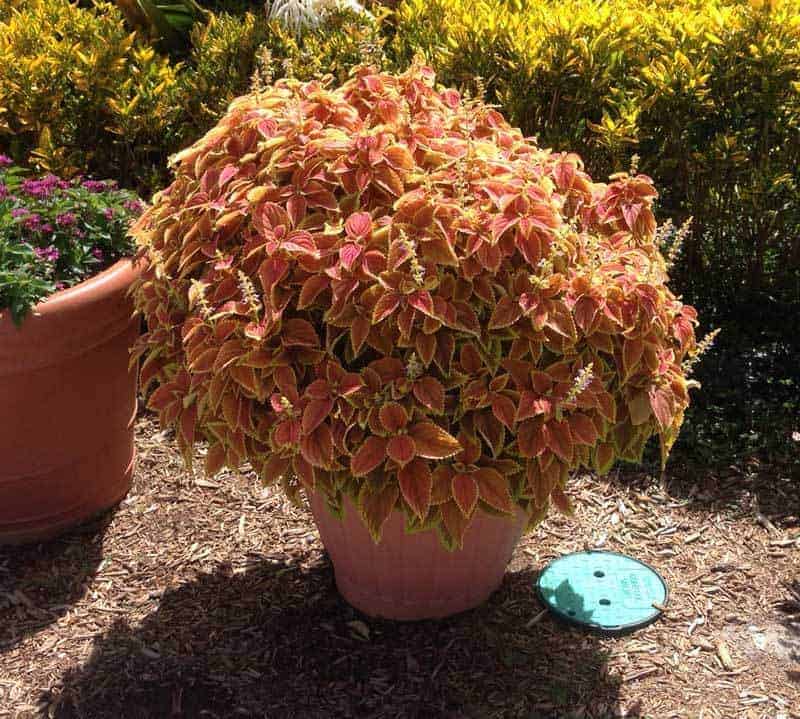
7 Steps To Make A Colorful Coleus Frame
Instead of growing coleus outdoors in a bed or a container with a few varieties, how about a picture frame of coleus?
The folks over at Garden Gate Magazine show you how to create a frame filled with coleus in 7 steps.
Think of all the ways you could display this unique planting!
Related: Check it out via Garden Gate Magazine.
The video below shows how to make a succulent picture frame. Making a coleus picture frame is basically the same, except you are using coleus. Enjoy!
Growing Coleus Plants – Climate Counts
Plant coleus in the sun or afternoon shade, depending on your climate. If you live in a cool, humid area, full sun will bring out the best foliage color and the sturdiest plants.
Partial shade is preferable if you are in a hot, dry region. Remember, a little bit of sunlight exposure will make your plant color bright.
Coleus does not like cold temperatures but grows best at temperatures above 70° degrees Fahrenheit.
Plants should have lots of water, so they need a well-drained potting mix, not one where their roots stand in soggy soil.
A morning and evening sprinkling of water will be enough.
Even though plants will grow well in water alone, soil that is always wet is quite another thing; in this case, the roots will rot.
In hanging baskets, pots, or other containers, provide well-draining soil and give enough water to keep the potting soil moist. In containers without drainage holes, let the surface soil dry out a little just before watering.
Outdoors, water coleus about as often as you water garden annuals. The condition of the coleus leaves is a good soil moisture indicator.
Ensure you’re planting in humid places to encourage fast and healthy growth.
Leaves of dry plants droop. Leaves of plants that are too wet turn yellow.
Good Coleus Care Means Feeding Coleus Well
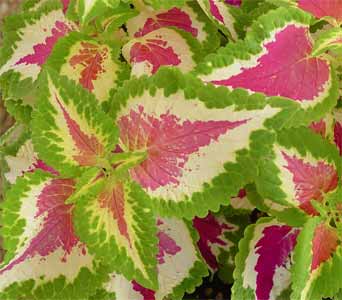
Fertilizer is necessary for vigorous growth. Either cow manure, a chemical fertilizer high in nitrogen, or liquid water-soluble fertilizer (which they love) is satisfactory.
Follow the manufacturer’s directions for feeding annuals or houseplants. If you want to keep the plants small, pinch the tips and give them a little liquid fertilizer.
Coleus Care Pest and Disease
Mealybug sometimes makes its home on this succulent plant indoors, but a regular shower of cold water usually keeps mealybug insects away.
A bit of cotton on a matchstick dipped in alcohol will kill those pests who do appear.
Take it easy when applying sprays during the heat of the day. Always follow the label of the applied product.
During hot, dry months, spider mite colonies can become a problem.
For help controlling spider mites, read this article – How To Get Rid Of Spider Mites Infestation (3 Organic Remedies)
Because coleus grows so well, sometimes the easiest control is to cut the plants down, throw away all debris, and apply insecticidal soap.
Downy Mildew
Downy mildew is a relatively “new” disease on coleus. “It was first observed in New York and Louisiana in 2005.
By 2006, it was found throughout most of the United States. Symptoms include leaves dropping off of plants, brown blotches on leaves, and stunted seedlings. Both seed and vegetatively propagated types are susceptible.” [source]
A Michigan State University study found sprays with the active ingredient called mandipropamid helped control downy Mildew. Another trial found success with “Stature DM 50WP, Pentathlon LF (mancozeb), Subdue MAXX EC, Insignia (pyraclostrobin).” Treatment with Terrazole 35WP (etridiazole) did not fair as well. [source]
Coleus Plant Care – Questions and Answers
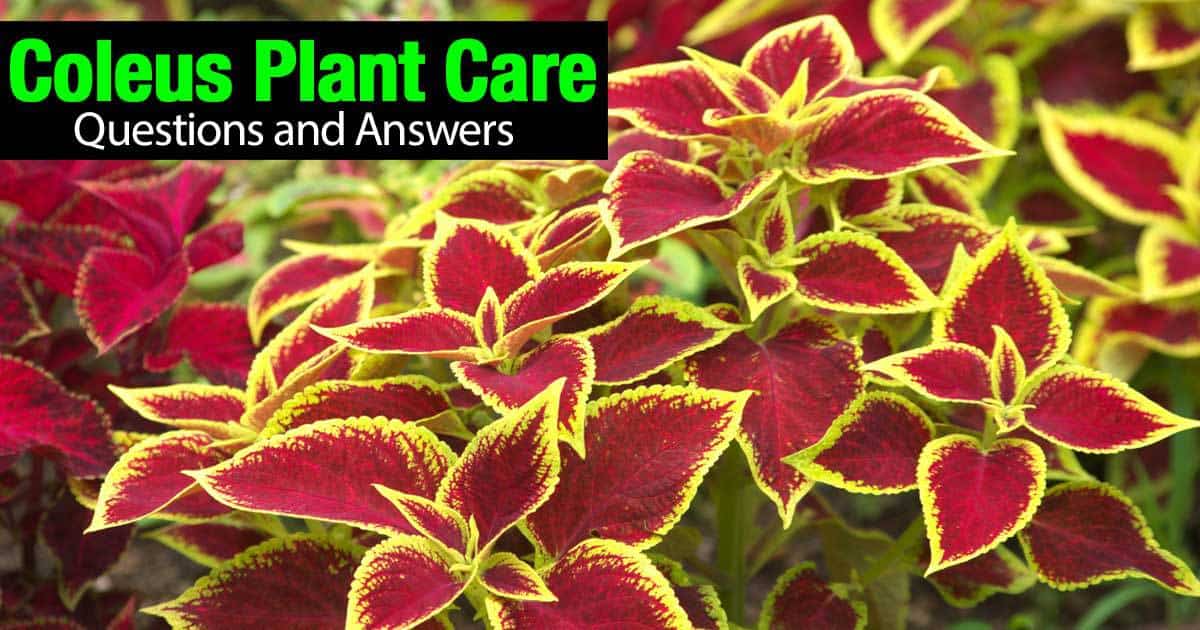
Question: Why is my coleus losing color after I have had them for a while?
I’ve tried them in east and south windows and also out of the direct sun, but they still fade. Is there a plant food that would correct this loss of color?
Answer: Coleus, to retain its bright color, must have three things.
#1 – It should have some direct sunlight (morning sun) for at least part of the day and as much indirect light as possible all of the time. These flowers grow in the sun very well!
#2 – It should have heat, 60° degrees or more, at all times and be planted in rich, well-drained soil that promotes rapid growth.
#3 – Soil containing good rich loam, sand, and some manure should maintain brilliant colors.
If your coleus has been potted for some time, regular feeding of high nitrogen liquid fertilizer such as Miracle-Gro will help to keep the leaves bright.
More On Coleus – Questions and Answers
Question: My houseplants, especially my Coleus, have masses of white, cottony insects. How can I rid the plants of these? JO, Indiana
Answer: One common Coleus enemy is the mealybug.
One way of dealing with mealybugs is to lay the plants in the tub or sink and wash them off with a forceful spray of water. The cottony masses may also be removed with a small soft brush dipped in alcohol.
Another control method is to repeatedly spray plants with neem insecticide oil or malathion until there are no mealy bugs. This is also the best method to control mealybug on hairy-leaved plants like African violets.
Question: How should one go about keeping coleus plants from the garden indoors over the winter?

Answer: In the fall, just before frost, take slips from the coleus and place them in good soil in pots and boxes indoors. Keep the slips watered, out of drafts, in a light warm place, and in about two weeks. They will be rooted, growing plants.
A few plants of coleus in the fall will usually give you all the new plants you need. Cutting is easier, better, and simpler than trying to take up the old plants.
Learn More in the section on Taking Coleus Cuttings.
Question: Why do some coleus grow straight up instead of branching out? I wish mine were bushier.
Answer: Coleus plants to be bushy need pinching. Do not hesitate to pinch the tip out of a coleus.
Pinch it as soon as it has three sets of leaves and keep pinching the side shoots as often as they get too long, up until the last of July.
Learn: How To Grow Coleus As A Tree: Step By Step
Question: Please tell me where and how you get seeds from Coleus.
Answer: Coleus plants bloom and set seeds as any other annuals do. To keep the plants bushy and vigorous, pinch the flower stem off. It’s not considered attractive anyway.
A better plan than growing coleus seeds would be to purchase them, either locally or by mail. One would likely get more variety and color from seed purchased than from seed saved from one or two plants.
Related Reading: Growing Coleus From Seeds
Coleus should be sown indoors early to get sizeable seedlings for spring planting outdoors. The seed comes up quickly, and eight weeks of growing indoors should produce bedding-size plants.
Question: Is Coleus poisonous?
Answer: Read our article titled – Are Coleus Poisonous To People, Dogs, Cats, Horses?
Coleus Plant Facts
Forskolin is an herbal extract from Coleus forskohlii, a plant belonging to the mint family.

What’s the mechanism of action? It increases the production of cyclic AMP, which increases the contractility of the heart muscle.
Evidence for other actions is preliminary and inconclusive: there is speculation that it may have effects in other cells of the body, such as platelet and thyroid cells, it may prevent platelet aggregation and adhesions, and it might even prevent tumor cell growth and cancer metastasis.
So far, there is no evidence that it is clinically useful or safe for those purposes. [source]
Closing Thoughts on Coleus
Coleus is a versatile plant and can be enjoyed year-round.
Use red coleus flowers inside in foliage arrangements or plant them in soil, living in the same jardiniere in the house for winter and as it did on the terrace in summer.
In either location, it will provide branches of multicolored foliage for bouquets and more plants. The big requirement is sunshine to keep the leaves bright in color.
Select your first plants carefully, choosing those that are quite different in form and color. Don’t overlook the smallest seedlings… they are often the prettiest.
images: source
